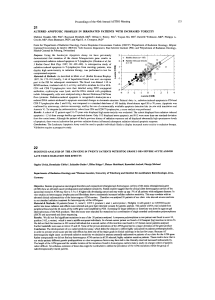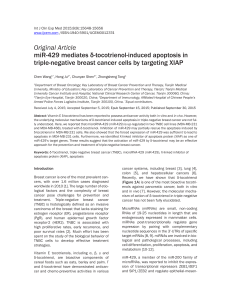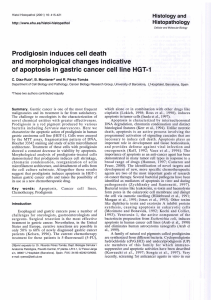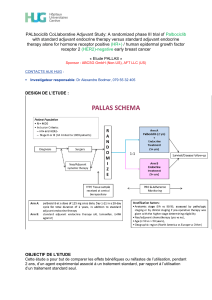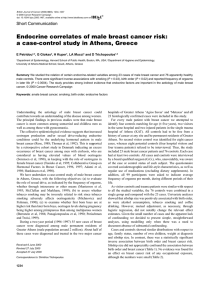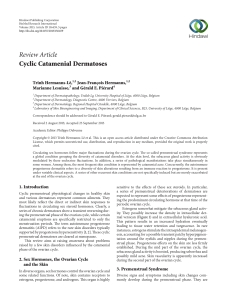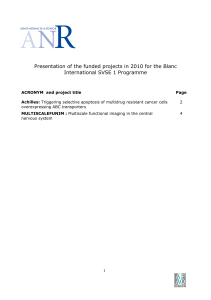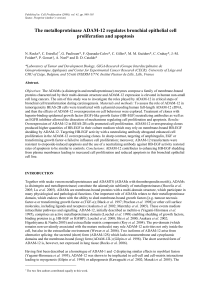Published in: European Journal of Cancer (2000), vol.36,suppl.4, pp.S81-91
publicité
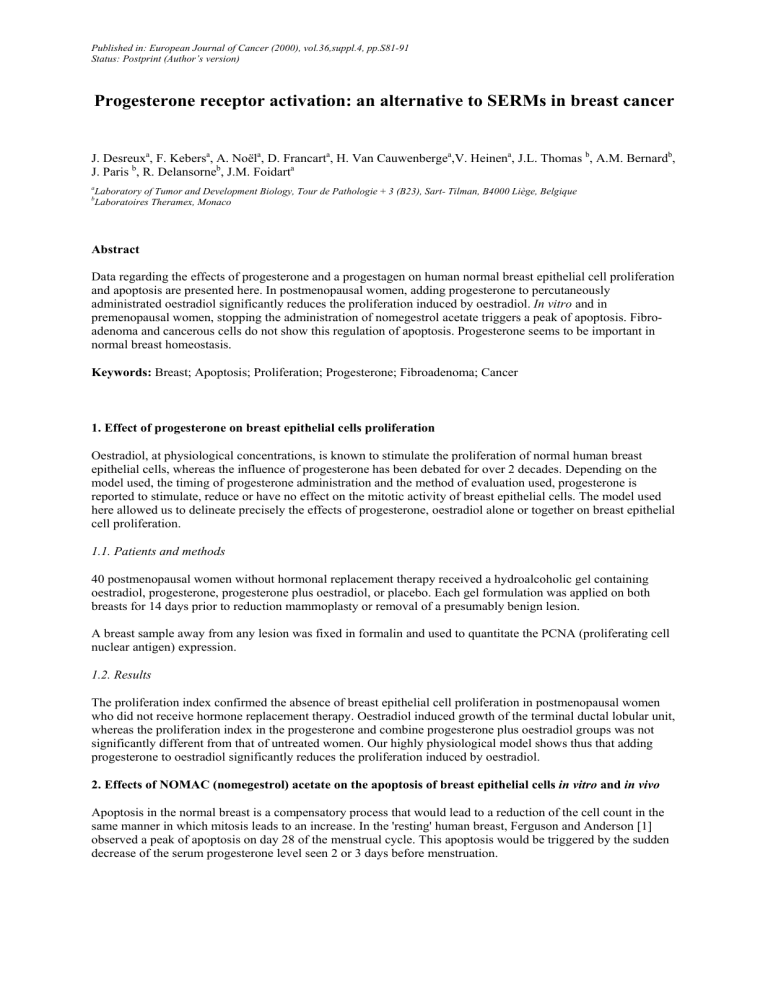
Published in: European Journal of Cancer (2000), vol.36,suppl.4, pp.S81-91 Status: Postprint (Author’s version) Progesterone receptor activation: an alternative to SERMs in breast cancer J. Desreuxa, F. Kebersa, A. Noëla, D. Francarta, H. Van Cauwenbergea,V. Heinena, J.L. Thomas b, A.M. Bernardb, J. Paris b, R. Delansorneb, J.M. Foidarta a b Laboratory of Tumor and Development Biology, Tour de Pathologie + 3 (B23), Sart- Tilman, B4000 Liège, Belgique Laboratoires Theramex, Monaco Abstract Data regarding the effects of progesterone and a progestagen on human normal breast epithelial cell proliferation and apoptosis are presented here. In postmenopausal women, adding progesterone to percutaneously administrated oestradiol significantly reduces the proliferation induced by oestradiol. In vitro and in premenopausal women, stopping the administration of nomegestrol acetate triggers a peak of apoptosis. Fibroadenoma and cancerous cells do not show this regulation of apoptosis. Progesterone seems to be important in normal breast homeostasis. Keywords: Breast; Apoptosis; Proliferation; Progesterone; Fibroadenoma; Cancer 1. Effect of progesterone on breast epithelial cells proliferation Oestradiol, at physiological concentrations, is known to stimulate the proliferation of normal human breast epithelial cells, whereas the influence of progesterone has been debated for over 2 decades. Depending on the model used, the timing of progesterone administration and the method of evaluation used, progesterone is reported to stimulate, reduce or have no effect on the mitotic activity of breast epithelial cells. The model used here allowed us to delineate precisely the effects of progesterone, oestradiol alone or together on breast epithelial cell proliferation. 1.1. Patients and methods 40 postmenopausal women without hormonal replacement therapy received a hydroalcoholic gel containing oestradiol, progesterone, progesterone plus oestradiol, or placebo. Each gel formulation was applied on both breasts for 14 days prior to reduction mammoplasty or removal of a presumably benign lesion. A breast sample away from any lesion was fixed in formalin and used to quantitate the PCNA (proliferating cell nuclear antigen) expression. 1.2. Results The proliferation index confirmed the absence of breast epithelial cell proliferation in postmenopausal women who did not receive hormone replacement therapy. Oestradiol induced growth of the terminal ductal lobular unit, whereas the proliferation index in the progesterone and combine progesterone plus oestradiol groups was not significantly different from that of untreated women. Our highly physiological model shows thus that adding progesterone to oestradiol significantly reduces the proliferation induced by oestradiol. 2. Effects of NOMAC (nomegestrol) acetate on the apoptosis of breast epithelial cells in vitro and in vivo Apoptosis in the normal breast is a compensatory process that would lead to a reduction of the cell count in the same manner in which mitosis leads to an increase. In the 'resting' human breast, Ferguson and Anderson [1] observed a peak of apoptosis on day 28 of the menstrual cycle. This apoptosis would be triggered by the sudden decrease of the serum progesterone level seen 2 or 3 days before menstruation. Published in: European Journal of Cancer (2000), vol.36,suppl.4, pp.S81-91 Status: Postprint (Author’s version) 2.1. Materials and methods Normal human mammary epithelial cells cultures were obtained from reduction mammoplasties. Half of the cultures underwent a continuous treatment, and half underwent a withdrawal of NOMAC. The control cultures received medium without steroids. In situ detection of apoptosis was performed by terminal dUTP nick-end labelling (TUNEL) method, which labels fragmented DNA. 2.2. Results The cells unexposed to sex steroids and cells exposed continuously to NOMAC showed a low and constant level of apoptosis. On the contrary, human mammary epithelial cells which underwent withdrawal of NOMAC showed a peak of apoptosis after 24 to 30 h of withdrawal. These data were confirmed by measuring the caspase3 (the main enzyme implicated in apoptosis) activity in the culture lysates. The peak of apoptosis after NOMAC withdrawal was absent in T47D cancerous breast cells, suggesting that these tumoral cells have lost their endocrine regulation of apoptosis. 2.3. Patients 25 premenopausal women who asked for a reduction mammoplasty or undergoing removal of fibroadenoma applied to their breasts a hydroalcoholic gel containing NOMAC or placebo once a day, from days 1 to 14 of their menstrual cycle. Surgery was performed on day 15. Serum levels of progestins and oestradiol, tissue levels of PR (oestrogen receptor) and ER (oestradiol receptor), and tissue levels of oestradiol were similar in each group. Apoptosis was detected on breast sections using the TUNEL technique. 2.4. Results The epithelial cells of normal breasts treated by NOMAC showed a significantly higher level of apoptosis compared with their placebo counterparts. In fibroadenomas, the rate of epithelial cells apoptosis was higher than in normal breasts, but did not vary accordingly to the breast exposure to progestin. Since the last application of gel was done about 24-30 h before surgery, it is likely that a decrease in the tissue level of NOMAC would be responsible for the induction of apoptosis in the normal breasts. Fibroadenoma epithelial cells did not respond to this stimulus. 3. Conclusions Altogether, these data indicate that adding progesterone to oestradiol significantly reduces the proliferation induced by oestradiol. Exposure to synthetic progestins (and probably progesterone) in vitro and in vivo significantly increases the apoptosis rate of human mammary epithelial cells. Progesterone and progestins may prevent breast hyperplasia when used for 14 days per month at substitutive doses in cyclic treatment. References 1. Ferguson DJP, Anderson TJ. Morphological evaluation of cell turnover in relation to the menstrual cycle in the 'resting' human breast. Br J Cancer 1981, 44, 177-187.









